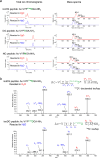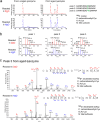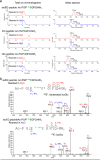Deuterium Labeling of Isoaspartic and Isoglutamic Acids for Mass Spectrometry Analysis
- PMID: 38344941
- PMCID: PMC10984558
- DOI: 10.1021/acs.analchem.3c05194
Deuterium Labeling of Isoaspartic and Isoglutamic Acids for Mass Spectrometry Analysis
Abstract
Isoaspartic acid (isoAsp) is a common protein modification that spontaneously arises from asparagine or aspartic acid and has been linked to various diseases and health conditions. However, current methods for identifying isoAsp sites in proteins often suffer from ambiguity and have not gained widespread adoption. We developed a novel method that exclusively labels isoAsp with deuterium. This method capitalizes on the unique structural characteristics of isoAsp residues, which possess a free α-carboxyl group and can form an oxazolone ring. Once the oxazolone ring forms, it facilitates racemization at the Cα-position, incorporating a deuteron from a D2O solvent. The sites of deuterium-incorporated isoAsp in proteins can be unequivocally determined by comparing the precursor and product ion masses of the peptides from proteins reacted in H2O and D2O. The effectiveness of this method has been demonstrated through its application to model proteins lysozyme and rituximab. Furthermore, we have confirmed that the isoAsp deuterium-labeling reaction efficiently labels both l- and d-isoAsp without distinction, as well as isoglutamic acid (isoGlu), for which no effective detection methods currently exist.
Conflict of interest statement
The authors declare no competing financial interest.
Figures






References
-
- Roher A. E.; Lowenson J. D.; Clarke S.; Wolkow C.; Wang R.; Cotter R. J.; Reardon I. M.; Zurcher-Neely H. A.; Heinrikson R. L.; Ball M. J.; Greenberg B. D. Structural alterations in the peptide backbone of beta-amyloid core protein may account for its deposition and stability in Alzheimer’s disease. J. Biol. Chem. 1993, 268, 3072–3083. 10.1016/s0021-9258(18)53661-9. - DOI - PubMed
Publication types
MeSH terms
Substances
Grants and funding
LinkOut - more resources
Full Text Sources

